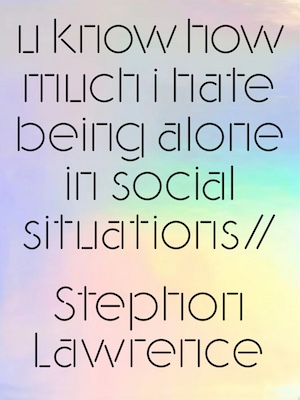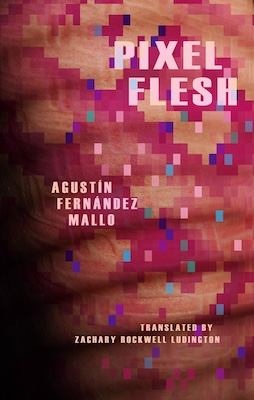One of the first forms my creative writing students adopt is the list. I love a list for its generosity and promiscuity, its non-hierarchical logic and stochastic lineation, its tendency to produce itself: to advance—accumulate—through coincidences and association and proximity, reassembling under the approximate logic of adjacency and wish fulfillment. Anyone can write a list and no list is complete; each item, like one site among a constellation, points us to other things or other futures. This list, too, is not meant to be an exhaustive inventory of poetry books about digital life or even an inventory of poetry books about the internet. Like media artist and curator Marisa Olson, who used the term “postinternet” in 2006 to describe a growing canon of art under the influence of the internet—work that described and critiqued nascent conditions of production and distribution; emerging social relations structured by obscured power dynamics—I think of the books on this list as work that observes and interrogates norms that we associate today with new media and networked capitalism, mining and miming the markup languages and polyphonic rhythms of the internet for glitches that might re-write the programmatic whole. Since at least 2017, when poet and digital poetics theorist William Lessard and The Brooklyn Rail described me as “Frank O’Hara traveling the hyper-connected contemporary landscape via iPhone” (“Adventures in Self-Voyeurism”), my work has been increasingly treated through its engagement with persona curation, surveillance cultures, glitch aesthetics, and the dislocative cadences of migration and passing.
With my latest book, a full-length collection of poems called Windows 85, I use address and apostrophe to kink the generative fictions of screen play, channeling the epistolary affect of digital interactions to clarify the melting point of incommensurable copresence; a form of wanting that has nothing to do with fulfillment or even pleasure—the redemption of an intimacy actualized through distance, blur, and withdrawal: “… how I want to be close to you / because I feel this way but I wouldn’t feel this way / if we were together.” The encounters that occur in Windows 85 appear and evaporate with a simultaneity that I want to liken to any streaming, always-on interaction, where the urge to join (with) another person in an indeterminant “here” or “now” doesn’t just muddle a spatial-temporal order but the border between bodies, without which one can just as suddenly become the other.
One of the questions that prompted me to make this collection was: can I adapt my media theory to verse? There are so many great examples of novels in verse; maybe Windows 85 is theory in verse. Like the books on this reading list suggest, collections of poetry installed in digital cultures have a tendency to straddle or evade formal markers and generic categories, challenging readers to broaden our notions about what poetry looks like; what a poem does.
u know how much i hate being alone in social situations by Stephon Lawrence
With quick wit and earnestness, u know how much i hate being alone in social situations skims the everyday insecurities and traumas of being human, or part human, on again off again, amidst the cringe rituals of office share interactions and work emails, the theater box of Twitter, the spectacle of health and wellness, and the anomalous soundtrack brought by haphazard public transit—the almost imperceptible transition from person and persona, one’s inner world and the instantaneous public, a changeover collapsed by the fact of being always online. Stephon Lawrence’s poems harness the abridged spelling and slang of chatspeak and a polychromatic array of emojis in service of a self-aware address to an audience that is often imagined and always implied. Shifting from unsent voicemails to unfinished HTML script to celebrity rendezvous and dreams within dreams (within dreams), Lawrence’s speaker navigates heartache and clickbait with playful aplomb and deep vulnerability.
Hivestruck by Vincent Toro
As our relationship with the internet continues to update, reflected by the metaphors—network, swarm, multitude, assemblage—we deploy to understand “collective intelligence,” Vincent Toro’s Hivestruck traces a trajectory of media with punchy lyricism, anecdotal storytelling, and relentless experiments in form, reanimating a life that can be measured by the screens one has possessed or been possessed by. Toro’s code-switching, polysemic verse looks out as much as it looks in, detailing the zombification of watching and being watched in the “panopticonfederacy” with mic-drop parody and solemn observation. Hivestruck’s poems, organized into three sections, shift between ballads to braided haibuns to the Latin American décima to cleave poems to the crab canon—an invention of Toro’s which, in reversing the language of a poem’s first half, recreates the effects of a mirror on the bottom. Others take the form of persona poems in which Toro ventriloquizes machines and content moderators and, elsewhere, digital content itself, inverting lenses to address the reader-user: “I am an icon. My profile/page when double-clicked updates you/on my status. One million views … .” With its diffuse structure and theoretical concentration, Hivestruck reminds us of the possibilities both obscured and precipitated by the limitations we impose, whether or not we know it, on ourselves.
The Rendering by Anthony Cody
A poetry collection that serves as a counterarchive, The Rendering attends to the historical ledger that has not merely been omitted from the record but resists conventional representation. With no desire for “the whole picture,” these poems, many of which offer multiple pathways of reading through Anthony Cody’s use of annotation and enjambment, also upend the archival urge for totality. Cody combs digital public domains to collage historical ruin with contemporary ecocide, manipulating photojournalist Dorothea Lange’s photographs of the Dust Bowl, U.S. Weather Bureau reports, transcripts of UN climate change panels and interviews with Dust Bowl refugees with graphic design software to create a visual-verbal communication that, at times, resembles a galaxy of command prompts. The Rendering’s transgenerational scope reminds readers that environmental and economic precarity and mass displacement and migration must be understood as mutually constituted under the design of consumer capitalism, now as in the past.

Reps by Kendra Sullivan
Reps, like its title suggests, is a collection of poetry as a triptych, each part exercising the formal structure and thematic organization expected of a poetry collection. Kendra Sullivan diverts often, moving from the ventriloquism of machine-learning in “Exercises Against Empathy” to the repetition of an origin story in “A Typology of Possible Biographies,” whose poems all open with the expository mantra: “A story about.” Sullivan’s poems are observational, abbreviated, curious, and attentive, imbued with a self-reflexivity that allows her speakers to question the terms of their own representation, as well as the conditions of expression and production. Though it isn’t until the book’s third section, “Margaret, Are You Grieving?” where an unbroken narrative emerges: a young artist’s coming of age at Ground Zero. Like other books on this list, Reps edges the territories of the digital world and the very material ecological world to insist on an ethics of reparation, for our natural world and to one another.
Titanic by Cecilia Corrigan
Cecilia Corrigan’s Titanic, which was awarded the Madeleine P. Plonsker Emerging Writer’s Residency Prize by Lisa Robertson in 2013, was the first book I’d read that felt digitally native, in the sense that reading Titanic—an epistolary romance, a pitch for a TV show, a script for reality … all of these—felt like being on the internet: more virtual than cyberspace. Father of AI Alan Turing plays Corrigan’s protagonist, a man on the run, escaping love (and death) for the digital dreamscape of disembodied consciousness within a book of poetry interspersed with chatboxes and pop-up ads, correspondences between William and Alice James, appearances by Miley Cyrus and Katy Perry, transcriptions of late night talk shows and episodes of Buffy the Vampire Slayer, declaring that all of these, too, are poetry. In Titanic, as on the internet, everyone is playing a character, and maybe even themselves.
Throng by Jose Perez Beduya
Another recipient of the Madeleine P. Plonsker Emerging Writer’s Residency Prize (awarded by Jennifer Moxley in 2011), Throng investigates ruins of the present in the aftermath of limitless horizons: the catastrophe of experience and knowledge brought by the consummation of absolute access; that anything and indeed everything can be accumulated, seized, sorted, sold back to us, as us. The collection’s poems, many of them written in neat couplets and tercets, glimpse a narrative that can only look back, that can only sift through fragments, without any attempt to restore or redeem. Jose Perez Beduya’s hushed tones drape his matter-of-fact lyric cycles in a vaporous lullaby that haunts and disorients, mirroring the speaker’s hunt for an identity premised on simulation, a sense of subjectivity absent individuation, in which narrative relation is often constituted by the re-citing of a collective “we”: the anonymous throng of the title. But Beduya’s book is not an examination of self and community so much as it is a reenactment of the patterns by which selfhood is continuously negotiated inside “the bright wheel” that acts as Throng’s leitmotif.
Pixel Flesh by Agustín Fernández Mallo, translated by Zachary Rockwell Ludington
Pixel Flesh (Carne de Píxel, literally “pixel meat” in the Spanish original), is a love story that substitutes plot for the information overload of media saturation. Like the small square of data belonging to its title, the book exploits its streaming prose form—presented in dual Spanish-English, as translated by Zachary Rockwell Ludington—while embedding its series of breakups with found texts lifted from Spanish periodicals alluding to science and philosophy, physics and metaphysics, scraps of quantum theory and the flotsam of code unmoored from an operating system: enmeshing the net/work of art and science. Agustín Fernández Mallo, whose background is in experimental physics, tests the limits of a pixel’s inherent drift toward reproduction and displacement—each pixel, after all, is just a sample of an original image, and Pixel Flesh’s story does not advance so much as iterate, collecting, in each successive sequence, fragments of memories that may or may not be the speaker’s own, a love that is endlessly displaced and thus endlessly desired.
Travesty Generator by Lillian-Yvonne Bertram
Years before OpenAI normalized conversational generative artificial intelligence with ChatGPT, which would become, two months after its launch, the fastest-growing consumer software app in history, programmer and poet Lillian-Yvonne Bertram was already adapting Python, JavaScript, and Perl programming languages to produce poems that counter dominant narratives of Black lives while critiquing the assumed neutrality of science and algorithmic objectivity. In Travesty Generator, Bertram pays heed to an ongoing history of Black erasure and the racialized surveillance and securitization that shapes and is shaped by biased technology, including the predictive analytics of search engines. Bertram’s collaborative permutations are incantatory and haunting, their versions and reversions channeling the lives and deaths of Trayvon Martin and Eric Garner—“People also search for: Emmett Till”; “People also ask what was Harriet Tubman’s life like?”—serving as both an elegy and the inauguration of a Black futurity. The ambiguity of most repurposed language divested of context is here reconveyed with urgency and social-political agency; Bertram’s self-reflexive poems interrogate the atrophy of cultural memory under an attention economy and, moreover, their own formal structures through a relation of violence that is implied and inevitable. But by recasting last words and returning a voice to Black bodies, restoring them to legibility and subjectivity by writing, as Bertram does in the early 14-part sequence, “Counternarratives,” from their point of view, Travesty Generator’s collaborations serve as a call to witness beyond the distancing gaze of science and social media.
MissSettl by Kamden Ishmael Hilliard
Kamden Ishmael Hilliard’s 2022 debut collection explores empire’s extant processes of racialization and colonialism with honesty and humor and a scathing playfulness that speaks to the poet’s use of mimicry as subversion. Like its title suggests, MissSettle is interested in unsettling the structures of language and logic, our assumptions about knowledge, literacy, belonging, and bodies, their institutionalized inscribing and cultural co-opting. Hilliard’s roving gaze sights transcultural practices, hyper-linking distant subjects, encounters, and histories with a stream-of-consciousness verve and vibe that wants to turn the paper into a screen and the act of page-turning into the dégagé scroll of social media, plus the offhand interjection that all of this is being composed on the go. “I don’t even want reparations/yet !” Hilliard’s speaker insists. “First , I will take a #3 combo/bc i’m hungry and a #2 pencil ,/not cause negros remain unprepared/for ontological warfare—but bc/I need to jot all this down.” Though it flaunts a velocity that mimics our contemporary cascade of content abundance, the book resists quick reading. Instead, Hilliard’s frisky and provocative asides and grammatical idiosyncrasies require we look back (look again) at the ways in which syntax and citizenship undergo interrogation, derangement, and revision in these poems salted with self-aware exclamation and dramatized ellipsis, the interlude necessary for a poetics of reconstitution.
The Kármán Line by Daisy Atterbury
Cross-genre and multidisciplinary, The Kármán Line rims perimeters, layers, boundaries both bodily and virtual, internal and public, geopolitical and extraterrestrial in pursuit of a novel epistemology, a thinking and a writing “in service of a togetherness.” Daisy Atterbury’s hypnotic narrative converges systems thinking and environmental studies with childhood anecdotes and often obscured histories of colonization, militarization, and securitization across interconnected sequences addressed to a lover, moving without signal from ruminative prose to the glitchy enjambment of verse amidst the insidious specter of radioactive fallout, from the galactic Zone of Avoidance to Sushi King and Spaceport America, from the coded come-ons of Tinder to the collected notes of Wittgenstein and cartographic recreations that reinscribe unequal realities. Along the way, readers witness the nascent encounters and non-encounters through which a love begins to take shape, never without Atterbury accounting for the potentiality of disaster or crisis, the etymological turning point when something irrevocably changes. Atterbury’s scope is generous; her voice tender, speculative, and mindful of the body undergoing various operations of dis/placement and re-embodiment across digital spaces and the dream of deep space—everything orbiting the motoric hub of desire, the necessity of being undone in order to be remade, together with another, gleaming what Atterbury calls “a radical softness,” a being (in touch), which is beyond descriptive narrative, beyond territorialization or metrics, beyond the regulatory divisions signaled by her debut collection’s title.
Read the original article here



